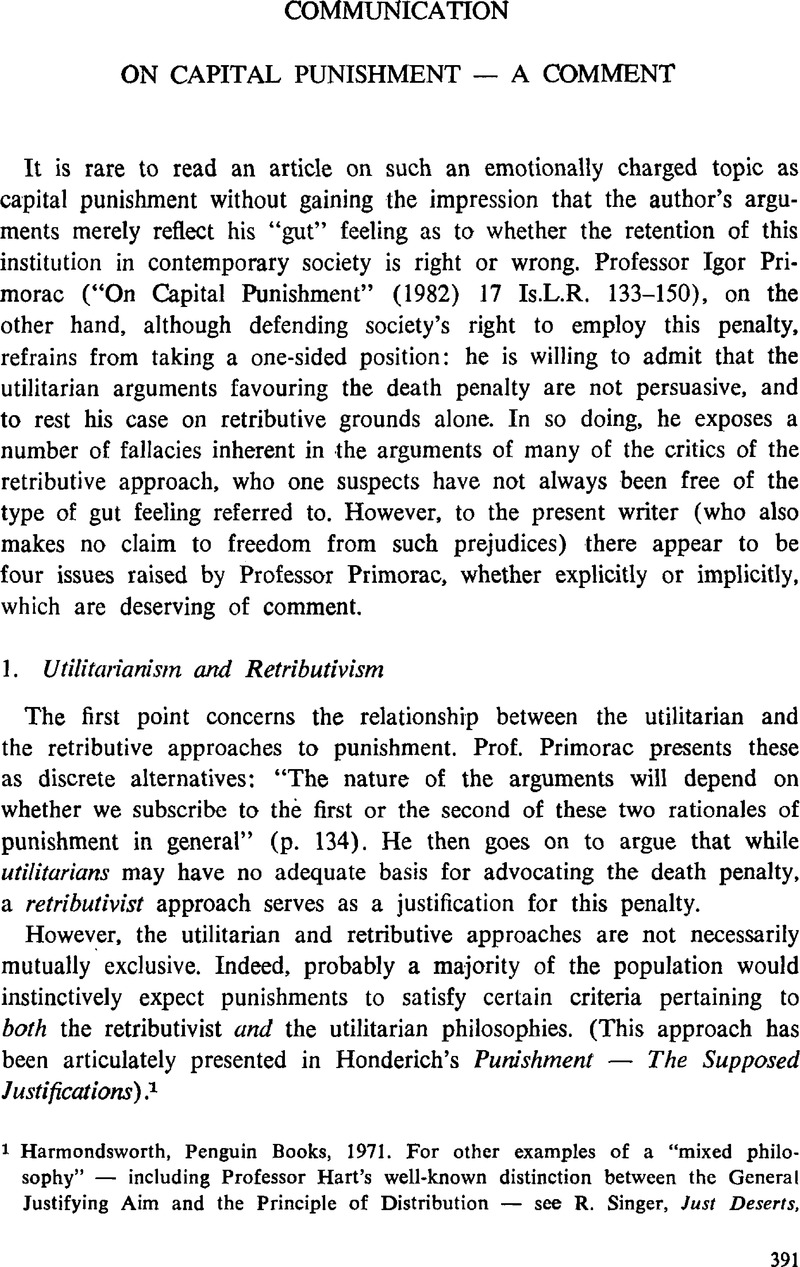No CrossRef data available.
Article contents
On Capital Punishment — A Comment
Published online by Cambridge University Press: 12 February 2016
Abstract

- Type
- Communication
- Information
- Copyright
- Copyright © Cambridge University Press and The Faculty of Law, The Hebrew University of Jerusalem 1982
References
1 Harmondsworth, Penguin Books, 1971. For other examples of a “mixed philosophy” — including Professor Hart's well-known distinction between the General Justifying Aim and the Principle of Distribution — see Singer, R., Just Deserts, (Cambridge, Mass., Ballinger, 1979)Google Scholar; see also, in the context of capital punishment, Radin, Margaret Jane, “The Jurisprudence of Death: Evolving Standards for the Cruel and Unusual Punishments Clause”, (1978) 126 U. Pa. L. R. 989, 1049–1056.CrossRefGoogle Scholar
2 Naturally this could not apply to an absolute retributivist of the Kantian school.
3 This explanation is sometimes offered for the high murder rates obtaining in the Southern states of the U.S., where capital punishment has been widely used.
4 Goldin, Hyman E., Hebrew Criminal Law and Procedure (New York, Twayne Publishers, 1952) 26.Google Scholar
5 Cf. Eggleston, Richard, Evidence, Proof and Probability (London, Weidenfeld & Nicolson, 1978) 102.Google Scholar
6 The controversial Baranes case comes to mind here. Irrespective of the final outcome of the pending investigation into the possibility of a miscarriage of justice in this case, can one imagine the moral horror which would accompany these deliberations were the defendant to have been executed?
7 Cf. Radin (op. cit., supra n. 1 at 1064): “If infallibility is to be required for any case, it should be required where the deprivation is irrevocable; and if infallibility is to be required in any case in which the deprivation is irrevocable, it should be required where the irrevocable deprivation is of life itself”.
8 The unequivocability of the tone (“no room whatever”) is somewhat modified by the qualification of the nature of the doubt (“reasonable”). Perhaps in capital cases, bearing in mind the irrevocability of the outcome, even unreasonable doubts may be entertained?
9 See e.g., Marshall, James, Law and Psychology in Conflict, (Indianapolis, Bobbs-Merrill, 2nd ed., 1980) Chap. 1.Google Scholar
10 Prof. Primorac's approach recognizes the occurrence of human error in the decision-making process. There thus seems to be a logical difficulty here: If we recognize the possibility of human error, how can we be sure that the assessment of a particular case as being free from error, will not itself be made in error?
11 Beccaria advocated the same principle but based it upon a deterrence philosophy. See Beccaria, Cesare, On Crimes and Punishments (Indianapolis, Bobbs-Merrill, 1963) Chap. XXIII.Google Scholar
12 Cf. Hart, H.L.A., Punishment and Responsibility (Oxford, Clarendon Press, 1968) 233–234.Google Scholar
13 See, e.g., Korn, Richard & McCorkle, Lloyd, Criminology and Penology (New York, Holt, Rinehart and Winston, 1960) 387.Google Scholar
14 Gardner, M., “The Renaissance of Retribution — An Analysis of ‘Doing Justice’”, (1976) Wis. L. R. 781–815.Google Scholar
15 See the publication of the Committee's Report: Hirsch, Andrew von, Doing Justice (New York, Hill and Wang, 1976) 138–139.Google Scholar
16 See, e.g., Wolfgang, Marvin E., “Current Trends in Penal Philosophy” (1979) 14 IS.L.R. 43–59.Google Scholar
17 These scales are produced by eliciting from respondents the attribution of scores for various offences or penalties, which- will reflect their seriousness or severity. This type of technique is known as “psychophysical scaling”, and was developed in a famous study by Sellin, T. and Wolfgang, M.E., The Measurement of Delin quency (New York, Wiley, 1964)Google Scholar. The application of the technique to the scaling of sanctions rather than offences, and the attempts to link the respective scales, are somewhat recent.
18 Present research seems to indicate enormous differences in the perceived severity of the death penalty and life imprisonment — at least where life imprisonment envisages an ultimate release. See: Sebba, L., Further Explorations in the Scaling of Penalties, Paper presented at the Annual Meeting of the American Society of Crimonology, November 1981Google Scholar; cf. Hamilton, V.L. & Rotkin, L., “Interpreting the Eighth Amendment: Perceived Seriousness of Crime and Severity of Punishment”, in Bedau, H.A. & Pierce, C.M. (eds.), Capital Punishment in the United States (New York, AMS Press, 1976).Google Scholar
19 See Von Hirsch, op. cit., supra n. 15, note on p. 139.
20 Cf. the Committee for the Study of Incarceration (above, n. 15), whose principle of “commensurate deserts” seems to incorporate the principle of Proportionality II: Equivalence as well as Proportionality I: Differentials. (See the opening statement of Chapter 8: “If one asks how severely a wrongdoer deserves to be punished, a familiar principle comes to mind: Severity of punishment should be commensurate with the seriousness of the wrong” (Italics in original)): Yet for murder the Committee suggested terms of imprisonment from five years and upward; there is thus no attempt to achieve equivalence in a literal sense. Other standards for determining proportionality in this sense are discussed in Radin (n. 1 above at 1057–1062).
21 See Cohn, H.H., “Talion” in Elon, M. (ed.), Jewish Law (Jerusalem, Keter Publishing House, 1975) col. 525.Google Scholar
22 Ibid.
23 The search for non-talionic equivalents is even more problematic: see Bedau, H.A., “Retribution and the Theory of Punishment”, (1978) 75 J. of Philosophy, 601, 611–615.CrossRefGoogle Scholar See also above n. 16. However, non-talionic equivalence provides no obvious justification for the application of capital punishment to murderers, and was thus not invoked by Prof. Primorac.
24 Cf. the “dignity” standard invoked by the U.S. Supreme Court: see Radin, op. cit., supra n. 1 at 1044–1045, 1053–1054.


